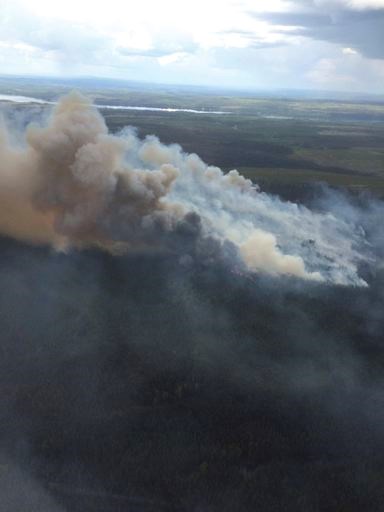A Prince George-area campaigner against the use of herbicides in the region's forests is pointing to the Little Bobtail Lake wildfire to support his position.
With the 25,000-hectare fire contained, James Steidle of Stop the Spray B.C. conducted a survey of the area and says he found that spots where there was a high percentage of deciduous trees like aspen did a better job of standing up to the blaze.
"It has long been known that aspen don't burn as readily as conifer trees like pine," Steidle said in a press release this week. "This fire is a good demonstration of how aspen can be used to benefit fire suppression and make our forests more resistant to fires and catastrophic failure."
Steidle said government law requires the elimination of aspen trees and makes it illegal for forest companies to allow mixed stands. Herbicides are routinely applied throughout this area to achieve this objective, he said.
Older, mixed stands from the 1960s and 70s, like the one on the east shore of Little Bobtail Lake, appeared to have fared better than more recent plantations, according to Steidle.
"Ironically, these stands weren't as aggressively managed as they are today and had high aspen content, which modern managers would see as a failure, but which in this case clearly helped it survive," Steidle said.
Phil Burton, an associate professor in the ecosystem science and management program at the University of Northern British Columbia, said Steidle has a point and noted the use of aspen as a firebreak has been advocated and tested in Alberta's Foothills and northwestern region.
"But I would add that it's a complex system related to what season of the year the fire happens and so forth," Burton said. "You could actually have hotter, more intense spring burns if the aspen stands have a grassy understory and it depends on whether it's leaf on or leaf off, and whether the sap has risen in the nearby pine trees and so forth, so it's not a black and white story by any means."
As for the use of herbicides, Burton said he would not abandon their use completely but suggested their use could be scaled back. Research he's done suggests herbicides are overused in the name of trying to accelerate the growth of specific species. The downside, according to Burton, is that a forest's resilience and ability to survive things like climate change, pests and forest fires is compromised.
Burton said the move away from mixed stands is the "product of a long and complex set of policies dating back to the 1980s" and has become "embedded in the provincial regulations."
"There was some movement in the late '90s in which they allowed one or two aspen stems within the influence zone of a designated crop tree of pine or spruce but I don't know even how flexible they are on that anymore," Burton said.
More research is need, according to Burton.
"It's difficult to provide management and policy guidelines to government when we no longer have the Science Council of B.C., we no longer have Forest Renewal B.C. funding to pursue these questions in any sort of fact-based manner," Burton said.
In a response to Steidle's press release, a Ministry of Forest, Lands and Natural Resource Operations spokeperson agreed that deciduous species like aspen pose a lower fire risk than coniferous species.
But while they can lead to reduced fire behaviour in some situations, the spokeperson said the ministry cannot comment specifically on how they affected the Little Bobtail Lake fire because it was hot enough to achieve the second-highest ranking in the wildfire management branch's fire intensity ranking system. It was classified as an "extremely vigorous surface fire or active crown fire."
It was also noted that in B.C. trembling aspen grows in later successional stages with many shade-tolerant conifers, and is present most frequently on disturbed sites, including ones caused by wildfire.



